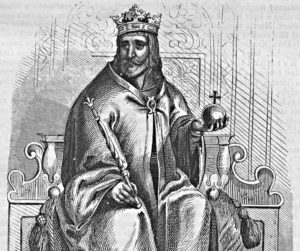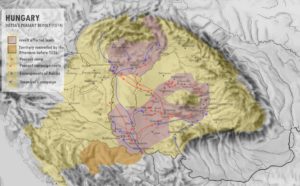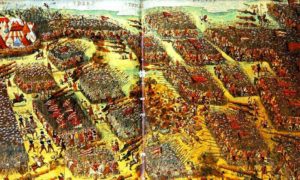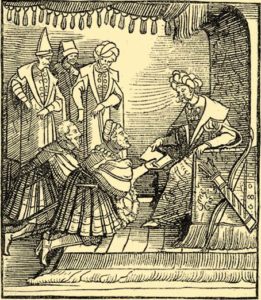King Szapolyai János (1487-1540)



Photo: Farkasven
No wonder, he was also the main contender for the throne by decree of the Diet of Rákos in 1505 because the assembled noblemen decided that no foreign king would be elected after the Jagiellonian kings. Thus, Szapolyai János was the candidate for the throne, supported by the crowds of the party of the common and medium-sized nobility. However, Lajos (Louis II), son of King Ulászló II, was born in 1516 so the decision of the Diet of Rákos did not come into effect.

As Szapolyai was the Voivode of Transylvania, he was also responsible for the suppression of Dózsa György’s uprising, which he did in 1514 at the Battle of Temesvár with the army he had tried the previous year at the siege of the castle of Szendrő in the Lower Danube. The crushing of the rebellion strengthened his authority in several ways: on the one hand, he had opposed from the outset the crusade launched by Bakócz Tamás on 16 April 1514 which triggered Dózsa’s uprising, and on the other, the crushing of the rebellious peasants increased his influence among the middle nobility and the baronial class.

He executed the leaders of the uprising with particular cruelty and took part in the creation of punishing laws against the peasants, but later he regretted it. In the years that followed, during the Jagello era, he was involved in the turbulent state of the country and in the various party struggles, which he sought to use to his own advantage to pave the way for his election as king.

In the 1520s, there were three separate military forces in Hungary, which in itself indicates feudal fragmentation. In addition to the king’s army, another army was commanded by Palatine Báthori István, and Szapolyai János, the Transylvanian Voivode had an army, too. In 1515, the Palatine and the Voivode were already raiding the southern Borderland of the kingdom. However, their aim was not to launch an anti-Turkish war (campaign) but to undermine the (third) Jagiello-Habsburg dynastic treaty of 1515.

In the event of their insignificant success in the war, the authority of the Habsburg party would have been severely undermined. The Fugger banking house’s representative in Hungary wrote to his boss: “if the Voivode had won at Zsarnó, the Hungarians would have reclaimed Anna and given her to the Voivode, and nothing would have come of the treaty… if he had succeeded in winning, he would have gained the glory of the throne and would have been given the king’s daughter as his wife.”

However, the siege failed, but it did draw the Ottomans’ attention to the country. After the death of King Ulászló II, the child Lajos (Louis) II came into power. His guardians were Bornemissza János and George of Brandenburg so the Habsburg orientation of the government was unbroken. Yet, the rest of the country’s leadership (middle and lower nobility) was more in favor of Szapolyai, so the period 1514-1526 was unstable in terms of domestic politics, central power was weak, and everyone obeyed only what they thought was right from the decisions and laws of the Diet.

From 1521 onwards, a permanent Turkish force was stationed in the Szerém region. The southern Borderland castle system established by King Zsigmond (Sigismund) was destroyed in a few years; Szabács, Nándorfehérvár, and Zimony were lost. The territorial integrity of the country was already damaged since 1521, with the Turks occupying territories as big as some counties.

In 1522, Szapolyai helped Radu Afumați to the throne in the Wallachia, who swore allegiance to the Hungarian king through him. Szapolyai did not have good relations with the royal court of Buda, he did not even appear at the 1525 Diet (otherwise he had just lost a battle with the Turks on the border of the Temes Dukedom), and according to his contemporaries he lived in Transylvania as an “internal exile”. His distress was growing by the fact that Palatine Werbőczy István made a decision against him in favor of the Habsburgs, and he could not get the inheritance (a huge domain and treasure) of the Újlaki family. At the same time, King Lajos II (Louis) demanded the return of his pledged royal estates.

In 1526, at the news of the approach of Sultan Suleiman I, he set off with his Transylvanian troops for Mohács but did not arrive on the battlefield. His army (which, according to some exaggerated estimates, numbered 40,000, but in reality, only 10-15,000) was stranded at Szeged.

According to some, he has still an unclear role in the Battle of Mohács. Others believe that he had goodwill, but because of the king’s contradictory orders, he ‘missed’ the battle of Mohács. Some believe that he deliberately delayed the battle, letting his monarch down on the battlefield of Mohács out of the cold calculation, thus paving the way for his rise to kingship. Since he could not lead his army to Mohács, he set off alone to take part in the battle with Tomori Pál but he was late, nevertheless. Regarding the death of King Lajos II, the Chronicle of Szerémi György says that it was Szapolyai György, the brother of János who killed the king at Székcső after the battle but the value of this source is debated by Hungarian historians.

The Battle of Mohács can also be assessed by the rate of losses in the number of high aristocrats: one king, 28 barons, 7 high priests and most of the county priests died. The top and middle levels of the state administration were thus practically extinct, since, for example, the royal council (i.e. the government) was composed of barons and high priests. This caused an immediate crisis of governance and administration. After the death of King Lajos (Louis) II, Szapolyai and his intact army were stranded near Szeged even as the Turks took Buda and then Pest without a sword stroke. The Turks left the country without a battle by 13 October.

Szapolyai was elected king after the withdrawal of the Turkish armies and crowned on 11 November 1526 at the Diet of Székesfehérvár, in opposition to King Ferdinand I of the House of Habsburg. At that point, he enjoyed 90% of the support of the kingdom’s noblemen and barons. The crowning with the Hungarian Holy Crown was performed by the senior high priest, Bishop Podmaniczky István of Nyitra. According to Hungarian law, only the Palatine (at the time Báthori István) could convene a Diet in the absence of a king, and Báthori had sided with the Habsburgs.
Thus, the Diet itself, which elected Szapolyai, was without a title. The reign of Szapolyai was based on a royal council without a Palatine, and it is unprecedented in the history of the country for a monarch not to have a Palatine. He probably did not appoint anyone because it would have meant an open break with the legitimate Palatine who was Báthori István.

The few supporters of Habsburg Ferdinand were not idle, either: barely a month later, 13 nobles and high priests of Hungary met in Pozsony (Pressburg, Bratislava) and elected Ferdinand Habsburg as King of Hungary. This Diet was called by Palatine Báthori István. Let us note, that after the Battle of Mohács Báthori fled straight to Dévény castle which controlled the Danube above Pozsony.
It was the reason why Ferdinand could enter Hungary undisturbed at all. The few lords who attended the Diet in Pozsony are known by name. From December 1526, the country had two kings: Szapolyai, under the name of János I, elected king at the Diet of Székesfehérvár based on the decree of Rákos in 1505, and Ferdinand I. Read more about Ferdinand’s life on my page:

The reign of Szapolyai began with a foreign policy failure: although he had declared his claim to the Bohemian throne, which had become vacant with the death of King Lajos (Louis) II, the territories of Bohemia, Moravia, and Silesia fell into the hands of the Austrian Archduke Ferdinand.

Szapolyai began to reorganize the Hungarian kingdom but he was hindered from the beginning by his opponent who instigated the Serbian Cserni Jovan to rebel against him. Szapolyai was able to put down this dangerous and bloody uprising only with the aid of those peasants whom he had punished so severely in 1514. You can read more details about this here:
https://www.hungarianottomanwars.com/1490-1541/1527-cserni-aka-black-or-nenad-jovans-uprising/
As propaganda, the Habsburgs began to suggest from 1528 that he had been in contact with the Sultan before 1526. Allegedly, there was a Venetian envoy who heard from a Turkish pasha that Szapolyai had wanted to create his kingdom in Transylvania with Ottoman aid. However, this rumor has not been credibly proven by historians since then. We know that he had contact with the Sultan only after 1528.

Immediately after the uprising of Cerni Jovan, Ferdinand’s army marched against Szapolyai and from then on a situation of civil war essentially became permanent between the supporters of the two kings, who often switched sides in the hope of increasing their possessions.

Thus, his reign was accompanied by warfare with the other king, Ferdinand. On 6 May 1527, the German-Spanish army of Emperor Charles V captured Rome. This event in world politics sheds a sharp light on the isolation of Sapolya’s foreign policy. The papal state was a member of the anti-Hapsburg League of Cognacs, and Sapolya wished to join the already defeated league. This also meant a kind of Turkish orientation, since Suleiman was a quasi-allie of the Cognacian League. In the same month, obviously, as a result of this foreign policy action, Charles V launched a campaign against Szapolyai. On 15 August 1527, Szapolyai left Buda without an actual siege and retreated as far as Tokaj, where a few thousand landsknechts caught up and defeated his troops. Szapolyai fled to Debrecen and then to Transylvania.

Stuck in Transylvania, Szapolyai tried to build another base to fight back against the Archduke. He raised a new army, recruited thousands of Polish mercenaries, and sent an envoy to King Francis I. He asked Venice and the Pope for financial aid but was unsuccessful.

On 20 March 1528, King Szapolyai’s forces suffered a decisive defeat at the Battle of Szina. By the end of 1528, Szapolyai had been completely driven out of the country and had emigrated to the castle of Tarnów in Poland. Ferdinand tried to get rid of him by sending an assassin after him. However, Szapolyai wrestled the attacker and killed him with his hands.

By this time, both the Assembly of Marovásárhely and the Assembly of Brassó had already accepted Ferdinand as their ruler. Most of the country was ruled by the Habsburg Archduke, who was now crowned king in Fehérvár under Hungarian law, as the Crown had also been transferred to him. Strange enough, it was carried out by the crown guard Perényi Péter who changed sides and joined Habsburg Ferdinand. Here is more about the story of Perényi Péter:
https://www.hungarianottomanwars.com/essays/lord-perenyi-peter-1502-1548-part-one/
Let us recall that previously Szapolyai had appointed him as Transylvanian Viceroy. Ferdinand was supported by the Austrian provinces and the Kingdom of Bohemia, as well as his brother Charles V, the German-Roman Emperor and King of Spain. Szapolyai sent envoys to Bavaria, the King of Poland, and several other states, but received no support. Finally was forced to turn to the Sublime Porte for help, and the alliance was signed with Suleiman on 27 January 1528, after a long and difficult negotiation. You can read about the details of his negotiations on my page:
https://www.hungarianottomanwars.com/1490-1541/1527-the-negotiations-of-sir-lasky-in-istanbul/

In October 1528, in Fontainebleau, Szapolyai allied with the French ruler, King Francis I, to obtain financial and diplomatic and financial support. However, he did not receive military support from King Francis I (who was expected to fight the Habsburgs in the east) and the French king urged him to make a deal with the Ottomans.

It was the Voivode of Moldova who attacked Ferdinand at first in Transylvania, and he was successful. On 10 May 1529, the Ottoman Sultan Suleiman I launched his second campaign in Hungary with a huge army, aiming to conquer Vienna, the seat of the German-Roman Empire. The Turks invaded Hungary and pushed Ferdinand’s forces out. The sultan and his grand vizier, Pargali Ibrahim Pasha, made Szapolyai pay homage to the Sultan at the site of the Battle of Mohács. Then, he was regarded as the King of Hungary again.

Suleiman retook Buda and gave the country and the Holy Crown of the Hungarians back to him. The Sultan chose the Hungarian national king because he wanted to have a vassal ruler to make the Hungarians accept Turkish rule. Besides, he was too focused on Vienna and did not have enough power to take East Hungary before soon. He cast his eyes toward the west, he needed his Kizil Elma (Golden Apple). Here is the reason why:
https://www.hungarianottomanwars.com/essays/the-ottoman-concept-of-kizil-elma-the-golden-red-apple/
Szapolyai ruled the country with a heavy hand, restoring the medieval Hungarian system of government. Historians take the widest possible variety of views on Suleiman’s intentions in Hungary. The research has suggested that the Ottomans followed the same multi-stage expansion pattern as in the Balkans. After the military defeat of a country (e.g. Serbia, Bosnia), the Ottomans set up a government with a Turkish orientation before annexing the country for good. According to this theory, Suleiman enabled the rule of Szapolyai and did not seize Buda earlier (in 1529) to make the pro-Turkish orientation popular before the final occupation.

Szapolyai did not participate in the attack on Austria, and he tried to break free from Suleiman. The Turkish alliance was not, of course, a neighborly favor; after a while, the Turkish Porte saw fit to keep its envoy in King Szapolyai’s entourage. He was Lodovico Gritti, the natural son of the Venetian Doge, now he was Sultan Suleiman’s man near Szapolyai. Gritti was elected as Governor in 1530.

Although there were attempts to make peace between the two kings, these resulted only in feeble truce agreements. In this situation, the majority of the Hungarian nobility tried to find a solution to the chaotic situation in the so-called kingless assemblies which were without success.

Meanwhile, Gritti began to play a double game with him, which almost threatened Szapolyai’s power. Sapolyai did not know how to get rid of him at first, because Gritti was a personal friend of Grand Vizier Ibrahim Pargali. In case of removing Gritti, he would be caught between Ferdinand and Suleiman. It didn’t make thing easier that Gritti wanted to get the Hungarian throne in secret. Eventually, the Transylvanians got Gritti out of the way in 1534 because Gritti murdered the Bishop Czibak Imre of Transylvania. Ferdinand again used this incident to his advantage and tried to get Suleiman to turn against Szapolyai.

As a result of the Franco-Hungarian alliance, in 1532, the idea of sealing the alliance by marriage was mooted, whereby Szapolyai would marry a female relative of King Francis I of France, the then 18-19-year-old sister of his brother-in-law, King Henry II (Albret) of Navarre, Isabella, who was the niece of Anne of Candale, the Hungarian queen and mother of King Louis II of Hungary. However, for unknown reasons, the planned marriage did not take place. It seemed that Szapolyai would die childless.

In the meantime, the two kings realized that their wars against each other favored only the Turks, and in February 1538 they concluded a secret peace treaty at Várad. It brought decades of internal strife to an end. In it, the two kings mutually recognized each other’s territories based on the status quo and agreed that after Szaolyai’s death, his part of the country would be inherited by Ferdinand and his successors.

However, the following year, King Szapolyai married Isabella of Jagello, the daughter of King Sigismund I of Poland. A year later she gave birth to a son, János Zsigmond István. The king, however, did not have much time left to raise his son. He traveled to Transylvania to put down the Transylvanian rebellions of Mayláth István, Balassa Ferenc, and Kendy Ferenc. There, not long time after receiving the news of his newborn son, he suffered a stroke. (Some gossip said he was poisoned, though.) According to a later account by Father Martinuzzi György, on his deathbed he made his loyal adviser swear that he would not abide by the terms of the Peace of Várad, but would put his son, János Zsigmond on the throne. Szapolyai died in Szászsebes on 17 July 1540.

Szapolyai’s chief men took three different positions. Some argued that the Peace of Várad should be enforced. Some argued that Ferdinand should only be given the throne if he tried to assert his right by force. Father György’s position – to reject the Peace of Várad altogether – was the third, and it prevailed. Szapolyai was buried in Székesfehérvár. His son succeeded him on the throne, in defiance of the earlier Treaty of Várad.

The aftermath of his reign
After his death, the country was divided into three parts for a hundred and fifty years: the Kingdom of Hungary, ruled by the Habsburg family, the Ottoman Occupied Lands that were part of the Ottoman Empire, and Szapolyai’s Eastern Hungarian Kingdom. It had a lot to do with Szapolyai’s widow, Queen Isabella. Read more about her role in losing Buda to the Turks in 1541:
https://www.hungarianottomanwars.com/dramatized-historical-writings/suleiman-before-buda/

There is still no consensus in public opinion about King Szapolyai’s policies. It is widely believed that Szapolyai was an Ottoman vassal – although Szapolyai did not pay taxes to the Turks in the years after 1529. However, his rival, King Ferdinand, recognized Sultan Suleiman as the arbiter of Hungarian affairs in 1533, while Suleiman symbolically adopted Ferdinand as his son and left the western part of Hungary in his hands as a fief. Thus, Ferdinand paid higher taxes to Suleiman to prevent war than Szapolyai ever paid.

The pro-Ferdinand contemporaries and much later pro-Habsburg historians accused Szapolyai of the same things (paying taxes, seeking approval from the Porte in Hungarian affairs, acknowledging the diplomatic superiority of the ‘Turkish emperor’ who addressed the Habsburg monarch as ‘King of Vienna’) that the Viennese policy of the time also did.

Eastern Hungary eventually became the Principality of Transylvania, formed in 1570 by the Treaty of Speyer from the eastern territories held by Szapolyai’s son. It was only thanks to the Peace of Zsitvatorok, which ended the Fifteen Years’ War, that the Habsburg monarch and the padishah became equal partners in diplomacy. It is not known when and why Suleiman decided to make the Kingdom of Hungary part of the Ottoman Empire. Suleiman himself wrote in a letter in 1541 that conquered Hungary was too far away from the empire in time, and that he, therefore, entrusted its leadership to Szapolyai. However, the alternative is that the occupation of Hungary was forced upon him by force, by the Habsburg threat, or that he was just using Hungary as a staging area and buffer zone.

There is a topos that King Szapolyai was of Slavic origin and his entourage, the royal court, was made up of Southern Slavs. As Kubinyi András points out, the idea was first put on paper by Szekfű Gyula, but, there is no proof that Szapolyai was Slavic, and there were just a few Serbs and Croats in the service of Szapolyai. The reference to Szapolyai as a Slavic king also appears in the nationalist literature of neighboring peoples.
Source: Szibler Gábor and Wikipedia
Dear Readers, I can only make this content available through small donations or by selling my books or T-shirts.
If you like my writings, please feel free to support me with a coffee here:
You can check out my books on Amazon or Draft2Digital, they are available in hardcover, paperback, or ebook:
https://www.amazon.com/dp/198020490X
or at https://books2read.com/b/boYd81


My work can also be followed and supported on Patreon: Become a Patron!http://Become a Patron!


https://hungarianottomanwars.myspreadshop.com/all




